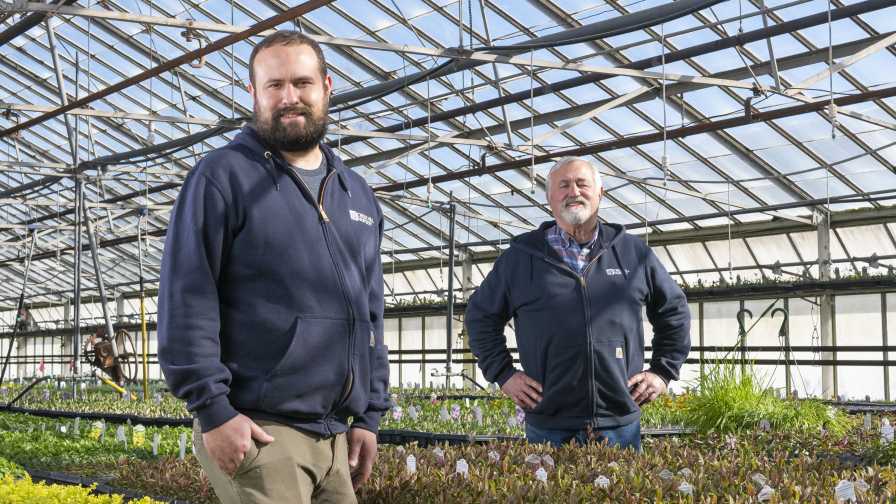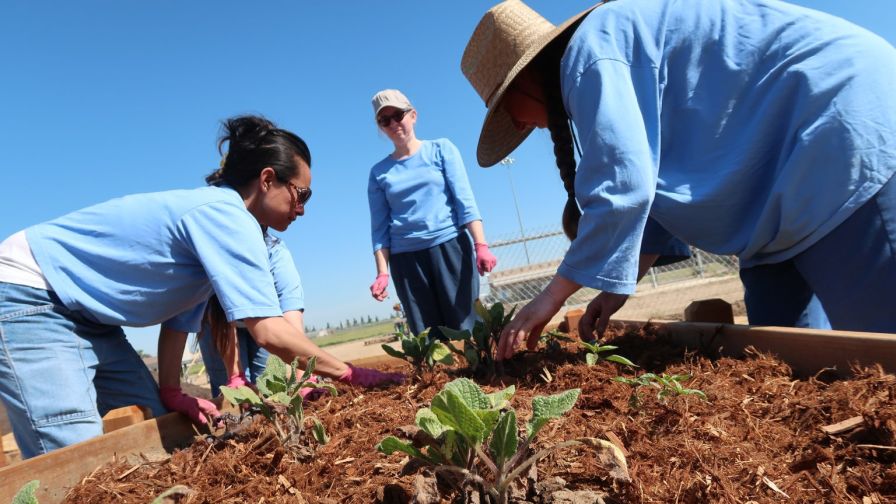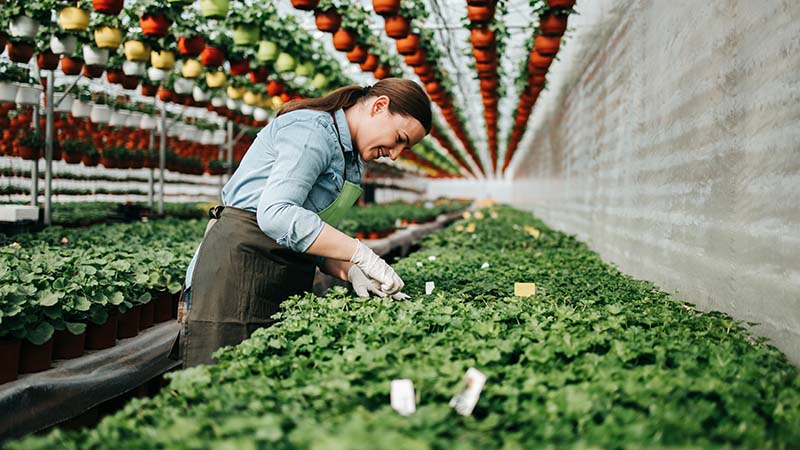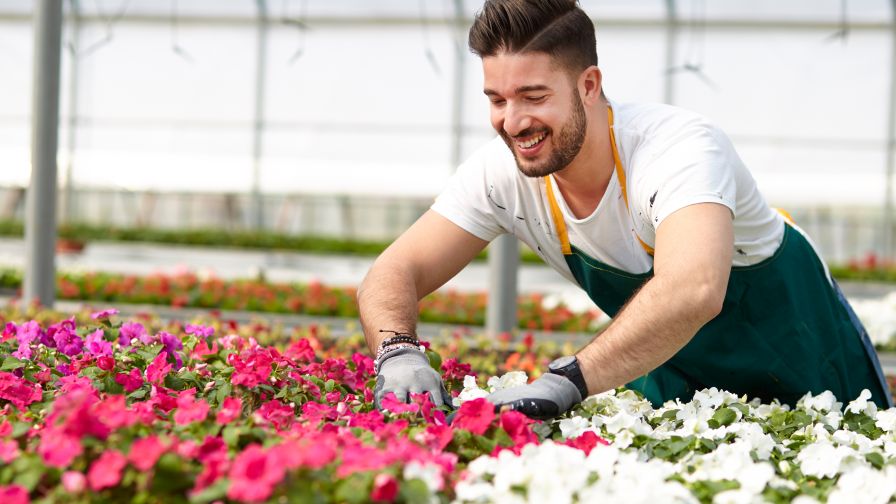How Creek Hill Nursery Brews up the Expected, and the Unexpected

Founded in 1990, Creek Hill Nursery began as a start-up by Ron Strasko (right), who runs the business with his son Ross Strasko. Ross will take over the full running of the company this year when Ron retires.
Photo by Eric Forberger
Creek Hill Nursery isn’t your average perennials grower. In fact, the company is at its best when its untypical behavior sets it apart. From unusual niche plants to compost tea brews to a team of passionate plant and insect geeks that make up the heart of the company, this greenhouse operation specializing in starter plants embraces innovation and diversity, leveraging the unexpected to work to its benefit.
Owner and President Ron Strasko worked for Green Leaf Plants for 15 years before deciding to purchase a couple of greenhouses in Leola, PA, and start propagating for himself. He used the Green Leaf method of purchasing greenhouses that were already up and running to eventually expand to five locations in Lancaster County with 5 total acres of production. Today the operation sells liners of hardy perennials, grasses, shrubs, and succulents to wholesale growers.
Ron’s son, Ross Strasko, is Vice President of Creek Hill Nursery and manages day-to-day business matters. Head grower Joel DiBernardo oversees the growing operation, backed by assistant growers and production people. A crew moves between the five locations to collect plants each week for shipping out of the Leola site. Ron’s personal touches, such as hand-written notes of appreciation to each employee at bonus time and a summer picnic for employees and their families, have helped the team bond and feel they are family.
“When I started Creek Hill Nursery, I asked myself ‘What would I want if I was working for me?’” Ron says. “I wanted people to feel that they were part of the business, and I think I’ve accomplished that with our team. It is truly a family business that includes them.”

Creek Hill Nursery offers a broad range of both genera and cultivars, which means greenhouses are full to the brim during the winter in preparation for spring sales. The company ships perennials coast to coast in the U.S. and Canada.
Photo by Eric Forberger
Niche Crops Are Creek Hill Nursery’s Forte
The Creek Hill Nursery family is full of plant geeks and a few insect geeks (we’ll get to that later) that work hard to provide customers with both the expected plant material, and the unexpected — cool, unusual, or groundbreaking cultivars that deserve attention.
The Straskos harbor a different growing philosophy about perennials that runs counter to the popular trend of annualizing perennials. Around 98% of the plant material Creek Hill Nursery grows is hardy to Zone 6 or lower, because how the perennial performs in the garden is more important to the Straskos than if it is blooming on the retail shelf.
“You see a lot more perennials on the market today that are not truly hardy, that bloom the first year and only last for a couple of years,” Ron says. “We’re against that trend. We want to grow good, hardy garden plants that people can enjoy for a long time.”
Creek Hill Nursery is adept at growing plants from tissue culture, which it receives from breeders around the world. The company also believes in pushing lesser-known products it trials and finds to be great garden plants that may not have a huge marketing push behind them. Each year, the company includes around 60 new plants in its catalog and drops about 40 plants off the list that aren’t selling well, don’t perform well in the garden, or can be replaced with a better plant. Sometimes, that better plant doesn’t always come from the larger, most well-known breeders.
“We do try to look at those smaller breeders because they have valuable things to bring to the market, and we want the best plants, not just the biggest company,” Ross says. “The smaller breeders aren’t always good at promoting themselves, so we like to promote their plants in our catalog and listings as long as those plants bring value to the market in some way.”
Producing some of these plants doesn’t always lend itself to hassle-free production or short crop turns. Yet, the team at Creek Hill Nursery is up to the challenge and doesn’t shy away from growing longer-term crops such as acanthus and epimediums. The Strasko’s mindset is if it is a valuable plant, they want to be able to provide it. Plus, there’s an additional benefit of producing plants that no one else will touch.
“When you’re chasing these commodity crops, everyone is growing the same thing. It all comes down to who has the lowest price,” Ross says. “If you’re diversifying healthily, you have things that nobody else has, and there are rewards for that. We could go for the cheap things, items that would turn three times by the time the epimedium tray is done, but there is real value to having that specialty and being the only company that is doing it. It sets you apart.”

Assistant Grower Laura Buck has been instrumental in advancing the operation’s biological program. The comprehensive program uses a combination of beneficial insects and fungi, vermacompost, probiotic soils, screened houses, and natural pesticides. The predatory mite Buck is applying is A. limonicus and is used during the colder months. When the warmer season comes, she will transition to A. swirski, which provides better control but isn’t as effective in cool temperatures.
Photo by Eric Forberger
Perseverance Pays Off With Biologicals
Creek Hill Nursery seeks to grow plants in the safest way for its team and its customers. When the company first started using biologicals to replace broad-spectrum chemicals or reduce their use, it was a daunting process that required some adjustments from the staff. However, the staff’s determination to master biologicals has resulted in the program evolving to get better and more effective every year.
A rigorous scouting regime is at the foundation of the biological program. The company also uses banker plants and has learned the value of providing a good habitat for beneficials to encourage them to remain in the greenhouse. Creek Hill’s Assistant Grower and onsite insect guru Laura Buck has been instrumental in advancing the biologicals program with her research, pest ID skills, and efforts to seek out the best ways to apply products. Her enthusiasm for bugs and the biologicals program is contagious with the team, the Straskos say.
The Torch of Leadership Passes from Father to Son
An open mind will assist Ross as he takes over the leadership of Creek Hill Nursery. This year, Ron plans to shift from heavy participation in the day-to-day operations to the joys of retirement that will involve traveling and antiquing with his wife.
Ron and Ross hired an outside company to help plan the transition. The company assisted with the financial arrangements and developed a plan to execute a smooth transition in leadership from Ron to Ross.
“We wanted to keep Creek Hill Nursery running smoothly” Ron says. “The company we brought in has been a big help with providing a framework to maintain continuity and to minimize hiccups as ownership changes.”
As this new chapter in Creek Hill Nursery’s history begins to unfold, the company stands willing and ready to embrace whatever the expected and the unexpected brings its way to keep its tradition of innovation and diversity running long into the future.
Compost Tea, Anyone?
Every plant in the greenhouse at Creek Hill Nursery receives a weekly dose of homemade compost tea through injection into the irrigation lines. Ross Strasko says he was skeptical of the program at first. Now, he’s happy to have been proven wrong.
“We started the program to add plant nutrients and promote root health, but what we discovered is the foliage benefits are huge,” Strasko says. “Foliar diseases are reduced with compost tea applications, especially Botrytis. Now we can’t stop applying it, or the disease issues quickly come back.”
To make the brew, compost is added to a container that is like a giant tepid jacuzzi. The water is agitated out of a catalyst or food source causing the compost bacteria to grow exponentially while the mixture brews. The process takes around 24 hours, depending on the time of year. When the mix is ready, a rich, living slurry is left that when applied to the plant foliage sets up communities of bacteria that crowd out injurious virus spores.
“You’re choosing what bacterial communities are on that leaf. When a harmful spore tries to drop onto it, the space is already occupied,” Ross says. “There’s a full living community that you chose, rather than a sterile environment that is just waiting for the spore to set up shop.”
Strasko says he has learned a valuable lesson from the compost tea project about exploring new ways of doing things — keep an open mind.











